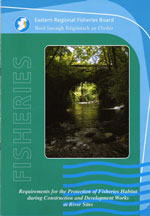Requirements for the Protection of Fisheries Habitat during Construction and Development Works at River Sites
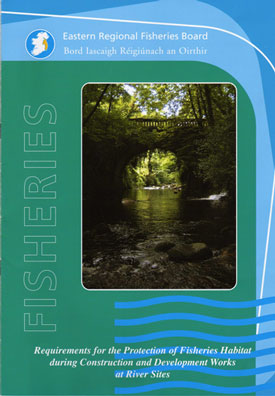
These Guidelines were written by Mr. Donal F. Murphy, BE FIEI MIFM,
with the assistance of staff of the Eastern Regional Fisheries Board
© THE EASTERN REGIONAL FISHERIES BOARD
15A Main Street, Blackrock, Co. Dublin.
- Introduction
- Fish & Their Requirement
- Impacts of Roads and Crossings
- Design Stage
- Rivers - Diversions/Realignments
- Run Off
- Construction Stage
- Instream Works
- Boards
- General Requirements
- Notes on Legal Protection to Fisheries Habitat
Introduction
The Fisheries Board is charged under the Fisheries Acts with the responsibility to protect and conserve all freshwater fisheries within its area of jurisdiction. Every river, stream, canal, lake, pond and reservoir within this area must be regarded as constituting and/or supporting a Fishery under the meaning of the Acts unless otherwise regarded by the Boards. The fisheries resource is also protected under national and EU legislation. Some notes on the legal protection given to fishery habitats are contained in Appendix I. While general and specifc requirements for the conservation and protection of the fisheries habitat may be set out in the planning conditions under which a project is approved, many issues regarding the timing, management, organisation, and methods of execution of the works inevitably arise during the construction phase. These Guidance Notes are aimed to identify the likely impact on fisheries habitat in the course of construction and development work, and to outline practical measures for the avoidance and mitigation of damage. These guidelines should not be regarded as all-embracing. Each project must be assessed on a case by case basis. It is, therefore, essential to consult with the Board. It may also be necessary to seek professional expert advice. All information contained in these guidelines were up to date at time of print.
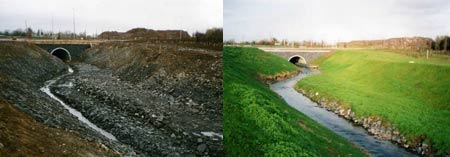
Comprehensive use of guidelines resulted in fisheries requirements included in the design. This watercourse supports a healthy population of plants, inverts and fish as a result.
Fish and their Requirements
Fish need unpolluted water and abundant food in a habitat that provides spawning areas, shelter and freedom of movement. The bed and soil of a natural river and the associated aquatic and riparian vegetation combine to provide the food chain on which fish depend. A natural river channel is characterised by the morphological features which are vital for the life cycle of fish: gravel shoals or reed beds for spawning, pools and riffles where fish rest and feed, and turbulent reaches which enhance oxygenation.
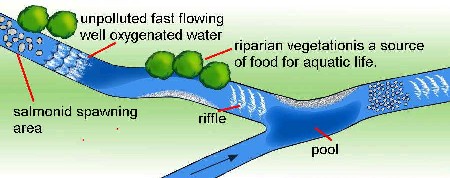
Fig. 1. Overview of River System
All elements of this natural environment must be protected. These guidance notes outline:
- important practical measures to minimise the impact of construction and development
- works on fisheries habitat.
Potential Impacts on Fish and Fish Habitat from Roads and Watercourse Crossings
| Barriers to fish passage |
|
| Water pollution |
|
| Removal of bed material |
|
| Disturbance of riparian vegetation |
|
Design Stage
Permanent River Crossings
1. BridgesClear span bridging is the preferable option, causing no changes to bed and banks and no impact on fish migration. If piers are required keep them slim-line to minimise changes to the channel. Bed and bank work should be executed in natural materials. Adequate clearance should be allowed under bridges for angler access and mammal passage, if required, particularly in the case of a motorway project.
2. Culverts
Culverts are likely to obstruct or delay upstream fish passage unless the depths and velocities of flow in them are within the swimming capabilities of the species to be catered for. Entry and exit conditions are also critical for ease of fish passage.
- Where possible, arch-type, "bottomless" units should be used so that the natural stream bed can be retained.
- The next best option is to use box culverts incorporating the design principles set out hereafter.
- The use of round/oval culverts should be limited to short runs and temporarycrossing.
Design Principles
1. Culvert should be as short as possible
2. Where the topography allows, they should be laid so as to remain backwatered
in drought flow to a depth of not less than 500mm at the upstream invert,
thereby providing a fishway over their full length.
3. In all cases, provisions must be made to ensure that the velocity of flow
will be less than the swimming speed which can be comfortably maintained by
the weakest upstream migrants.
4. Transition pools should be formed at each end to allow upstream migrants
to enter and exit without stress or delay.
5. Culverts should be daylit over their full length: if necessary, light-ports
should be provided at suitable intervals.
6. The use of trash screens should be avoided.

FIG. 2 Oversized Box Culvert Permanently Watered
Design Options
1. To conform to the principles set out above, culverts always need to be
oversized and, generally, laid below the river-bed grade level by about 500
mm.
2. Where the bed gradient is too steep for full backwatering, the best option
for achieving low velocity and adequate fishway is to provide a fish-pass
at the
downstream end, as shown in Figure 3.
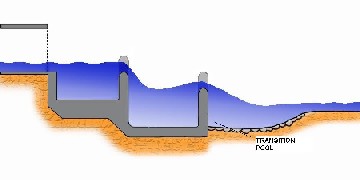
FIG.3 Fish Pass and Transition Pool at the Downstream End of the Culvert
3. Alternatively, the downstream water-level may be raised by providing one
or more ponding weirs below the outfall. Such weirs should have fish notches
to facilitate upstream movement. The pools formed by them should provide adequate
resting and take-off conditions for fish.
4. In some cases it may be acceptable to use notched baffles to control the
velocity and provide fishway in the culvert. As already recommended the culverts
should be oversized to compensate for flood conditions.
5. More rarely, shaping and roughening of the invert may serve to provide
flow conditions suitable for fish passage, especially during low flow. The
objective is to create a low flow channel along the centre of the culvert.
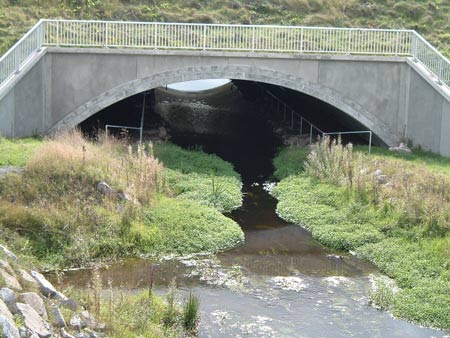
Permanent River Diversions and/or Realignments
While permanent diversions are not encouraged, in limited circumstances they will be permitted. The new channel should display hydraulic and morphological characteristics fulflling the requirements of fisheries habitats. Bed and bank work should be executed in natural materials.

Fig. 4. Example of realignment design
Road run-off
All surface water collected from the road drainage should be treated in a sustainable manner to minimize the impact on water quality and prevent habitat degradation. Treatment should be designed with adequate storage capacity and in a manner to facilitate maintenance.
Construction Stage
Minimising impact: Site Layout and Organisation
The following measures are critical for preserving water quality and aquatic
habitats.
1. Fuels, oils, greases and hydraulic .uids must be stored in bunded compounds
well away from the watercourse. Refuelling of machinery, etc., should be carried
out in bunded areas.
2. Run off from machine service and concrete mixing areas must not enter the
watercourse.
3. Stockpile areas for sands and gravel should be kept to minimum size, well
away from the watercourse.
4. Run off from the above should only be routed to the watercourse via suitably
designed and sited settlement ponds/filter channels.
5. Settlement ponds should be inspected daily and maintained regularly.
6. Temporary crossings should be designed to the criteria laid down for permanent
works.
7. Watercourse banks should be left intact if possible. If they have to be
disturbed, all practicable measures should be taken to prevent soils from
entering the watercourse.

Instream Works
1. Instream works may only be carried out in accordance with the Board's
general requirements set out below.
2. Preparatory works - such as constructing temporary crossings, forming cofferdams,
creating diversions, - must be carried out in accordance with an approved
Method Statement and under supervision by the Board's officers. Similar requirements
apply during removal and reinstatement.
3. Instream machine works should be minimised, and any machines working in
the watercourse must be protected against leakage or spillage of fuels, oils,
greases and hydraulic fuels.
4. Instream earthworks must be executed so as to minimise the suspension of
solids.
5. Construction works, especially ones involving the pouring of concrete,
must be conducted in the dry.
6. When cofferdams are being kept dry by pumping, the discharge must be routed
to an approved settlement facility before return to the river.
7. Every care must be taken to insure against spillage of concrete or leakage
of cement grout within cofferdams.
8. Temporary diversions may be used to facilitate working in the dry, subject
to permission by the Board. Advance notice must be given and a Method Statement
must be furnished and approved. Such approval will be subject to the Board's
officers being satisfied that the diversion channel can be so designed as
to accommodate fish migration.
9. The diversion channel should be formed in the dry, and arrangements should
be made for authorised personnel to remove all fish from the natural channel
before the flow is diverted.
Summary of the Board's General Requirements
- In salmonid catchments, all in-stream works should be carried out during the period May to September (see table on next page).
- In the event that these waters contain Lamprey it is necessary to contact National Parks and Wildlife Service for their requirements.
- No instream works shall be carried out without the written approval of the Board. A method statement must be agreed well in advance.
- The Board should be given sufficient notice before pre-approved in-stream works commence.
- If a section of watercourse is to be de-stocked work must be carried out by authorised personnel. If this work is to be carried out by Fishery Board staff, two to three weeks notice must be given and the cost will be recouped by the Board.
- There must be no discharge of suspended solids or any other deleterious matter to watercourses.
- Fish passage conditions must be maintained at all times.
| January | Instream Works Not Permitted |
|
| February | Instream Works Not Permitted |
|
| March | Instream Works Not Permitted |
|
| April | Instream Works Not Permitted |
|
| May | Instream Works Permitted |
|
| June | Instream Works Permitted |
|
| July | Instream Works Permitted |
|
| August | Instream Works Permitted |
|
| Sept | Instream Works Permitted |
|
| October | Instream Works Not Permitted |
|
| November | Instream Works Not Permitted |
|
| December | Instream Works Not Permitted |
|
Appendix 1
Some notes on Legal Protection given to Fisheries Habitat in Legislation
- The enforcement authority for inland fisheries is the relevant Regional Fisheries Board and the legislation charges them with the protection of fisheries and the general enforcement of the Fisheries (Consolidation) Act 1959(as amended).
- Since the Fisheries (Amendment) Act 1999 the Board was additionally required to have regard for the need for sustainable development. This includes: the conservation of fish and other species of fauna and flora habitat; biodiversity of inland fisheries and ecosystems; protection of national heritage within the meaning of the Heritage Act 1995.
- The Fisheries Act provides a wide range of measures to protect fish; however the protection of fishery habitat is limited to a number of sections of the Acts.
- Section 131 of the Fisheries(Consolidation) Act 1959 protects spawning salmon and trout and creates the offence that where any person during the annual close season: wilfully obstructs the passage of salmon or trout or the smolts or fry thereof. or injures or disturbs any salmon or trout, or any spawn, fry or smoltsthereof. or injures or disturbs any spawning bed, bank shallow where such spawn of fry or smolts may be, commits an offence with a maximum penalty of 12 months in jail and €635 fine may be imposed.
- Section 171 of the Fisheries(Consolidation) Act 1959 creates the offence of throwing, emptying, permitting or causing to fall onto any waters deleterious matter.
- Deleterious matter is defined as not only as any substance that is liable to injure fish but is also liable to injure their spawning grounds or the food of any fish or to injure fish in their value as human food or to impair the usefulness of the bed and soil of any waters as spawning grounds or other capacity to produce the food of fish.
- In addition to a maximum fine of €1,270 and six months imprisonment by the District Court, the full cost of the damage done and restoration is also chargeable against the offender - Section 10 of the Water Pollution Act 1977 (as amended by Section 7 of the Water Pollution Act 1990).
- Section 173 of the Fisheries Consolidation Act 1959 creates a number of offences which including that where any person: wilfully obstructs the passage of the smolts or fry of salmon, trout, or eels, or injures or disturbs the spawn or fry of salmon, trout or eels, or injures or disturbs any spawning bed, bank or shallow where the spawn or fry of salmon or trout or eels. Commits an offence as well as a penalty of €635 there is an additional provision that any engine device used in the commission of the offence shall as a statutory consequence of conviction stand forfeit.
- Fishery habitat protection has been urther enhanced by other national and E.U. legislation including the provisions under the Freshwater Fish Directive and the Habitats Directive. The Planning and Development Act 2000 also affords an opportunity for the pro-active protection of fisheries and fisheries habitat.
Summary of Relevant Legislation
- The Fisheries (Consolidation) Act 1959 (as amended).
- The Fisheries (Amendment) Act 1999 (No. 35 of 1999).
- The Freshwater Fish Directive - Council Directive on the quality of fresh waters needing protection or improvement in order to support fish life (78/659/EC) as transposed into Irish law under the E.C. (Quality of Salmonid Waters) Regulations 1988 (S.I. No. 293 of 1988).
- The Habitats Directive - Council Directive on the conservation of the natural habitats of wild fauna and flora (92/43/EEC) as transposed into Irish law under theE. C. (Natural Habitats Regulations 1997 (S.I. No. 94 of 1997).
- The Local Government (Water Pollution) Act 1977 (as amended).
- The Local Government (Planning and Development) Act 2000 (No. 30 of 2000).
Note: Full text of the above legislation can be accessed at www.irlgov.ie
